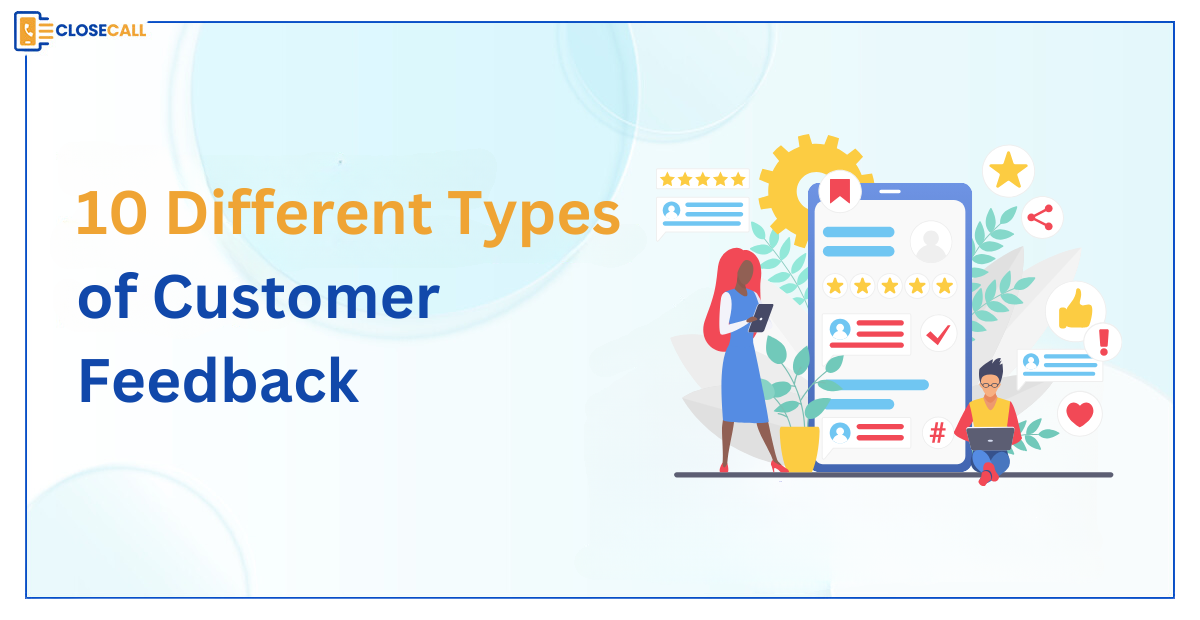Customer feedback is a very crucial part of any business, and customers are the frankest critics and ardent supporters of your product; thus, their input is a priceless source of information for your company. For this reason, client feedback is crucial for any company. We will talk about a few of the various types of consumer feedback in this piece. According to the study, 77% of buyers are drawn to companies that solicit feedback from their customers.
It is easy to become paralyzed by the sheer number of options when considering client feedback collection. It’s difficult to know where to begin with so many clients and ways to interact with their input. But one thing is certain: gathering client feedback proactively guarantees that you never veer too far from the needs of your community, even as those needs change. Different types of customer feedback impact businesses differently. Here are the top 10 types of customer feedback:
Types of Customer Feedback
Customer reviews and app ratings are examples of situations where you can get feedback from users without having to ask, and other times, you need to get in touch with them to get further input. It primarily depends on the size and activity level of your consumer base.
A selection of different types of customer feedback formats is provided below to help you expand your business.
Reactions to Review Websites
Before making a purchase, potential buyers typically read up to 10 reviews; therefore, review site feedback is a valuable source from which you can choose from different types of customer feedback. You can take immediate action based on the types of customer feedback you receive about your client satisfaction levels.
These uninvited reviews may be found in abundance on public review platforms like Trustpilot, Google Reviews, and the Better Business Bureau. Positive comments from internet reviews can also be utilized, and you can use them as testimonials on your website. These boost the legitimacy and dependability of your goods and services.
Unavoidably, bad customer reviews can occur occasionally. The good news is that you can also benefit from unfavourable types of customer feedback. According to research published in the Harvard Business Review, businesses that addressed unfavourable reviews had higher ratings than those that did not.
Negative client reviews might help you identify the aspects of your goods and services that still need improvement. This is not how you should react to a bad review. There are more refined approaches to managing both positive and negative customer feedback. Simply inform the client that you will investigate the matter and provide a prompt resolution. Go above and beyond by contacting them again to let them know the problem has been fixed. This is particularly crucial for long-term subscription goods and services that customers will consume.
Customer Survey Responses
Because surveys are quite straightforward to put up, scalable, and cost-effective, they are among the most widely used techniques for actively gathering client feedback. Additionally, surveys can be utilized for a wide range of purposes, from gathering precise, targeted input to comprehending high-level client sentiment. It is one of the vital types of customer feedbacks.
For example, customer satisfaction (CSAT) and net promoter score (NPS) surveys can be conducted using different types of customer feedback software programs. These surveys are commonly used to determine the level of customer happiness or displeasure. Customer Effort Score (CES) surveys, which are commonly used to gauge how hard consumers work to use a product or feature, are also supported by the platform.
Nevertheless, surveys can have certain drawbacks.
Initially, the context they provide for the data they gather is inadequate, making it challenging to discern the underlying motives or particular pain areas behind client answers. Several other factors, including non-response bias and differences in each respondent’s comprehension of the questions, could also cause this data to be erroneous or unrepresentative.
Pro tip: Narrowing the scope of your survey is an excellent strategy to get around the “context” restriction. Begin with a broad “premise question,” such as “How happy are you with your experience?” Subsequently, ask increasingly detailed “context” questions that gradually probe further into the respondents’ answers.
One of the greatest ways to get consumer feedback is through a customer satisfaction survey, which is a straightforward example of a survey that measures customer satisfaction.
Notable features include the survey’s straightforward design and its instructions, which make sure respondents know exactly what to do right away and aren’t overloaded with choices. Respondents are more likely to engage in this survey because it requires very little work on their part.
In-App Product Feedback
Additionally, you can use in-app polls to get feedback. These assist you in creating customer-driven developments, where you learn what to create and how based on the user’s experience and rating of your app. It is one of the significant types of customer feedback.
Additionally, you may utilize tools to gently prompt users on the app to ask the relevant questions at the right times without detracting from their experience. Tools with sophisticated targeting features assist you in comprehending:
- Where on the app are your clients?
- Their identity (details)
- How often do they use the app, and when do they visit it?
With the use of this data, you can better understand your customers’ wants and implement changes that will improve their future interactions with your company.
Focus Groups
Without taking a lot of time, focus groups are a useful tool for gathering consumer input. With the help of a moderator, focus groups comprise a small, representative sample of consumers—typically eight or so. These groups function as a forum for discussion on a certain item or topic.
While focus groups and usability testing are not the same thing, they can be useful in gathering feedback on a particular brand and its products. Because there were only a few participants in each focus group, the data gathered is typically qualitative and subject to bias. Clear research objectives, categorizing responses, and examining patterns that emerge from the gathered data, however, can help with brand awareness and product development.
Bug Reports
A software or product fault that results in unexpected behavior is called a bug. They may be expensive for the business and frustrating for the user. Three types of faults are commonly found in bugs: design bugs, coding problems, and implementation errors.
There will inevitably be bugs. However, problems can cause churn and a poor customer experience if they are ignored. Everyone dislikes a subpar product. Businesses should continually seek methods to improve customer service, such as by using bug-tracking technologies to fix issues as soon as possible to reduce attrition.
- How to address a bug report?
Bug reports are a crucial component of the feedback loop, which enables teams to comprehend how users interact with their product and identify issues that must be resolved to improve the user experience and attract new clients.
- Always inquire as to how and when the bug was discovered while attempting to remedy it.
- How does that impact the program? Is this a serious bug?
- How much time and money would it take to fix it?
- What actions are required to make it again?
With the help of in-app feedback widgets, you can gather user reviews and issues from within your program. By determining how many consumers they impact and how serious the issues are, your team can prioritize fixing the defects. A public product roadmap would also demonstrate to customers that you value their comments and are attentive to their experiences by updating them on the status of those bug reports.
Think about allowing your clients to report an issue or submit a ticket through a specialized bug-tracking website. A bug tracking application can give your team all the information they need to remedy the issue by giving them all the details about how customers are using the product.
Email and Customer Contact Forms
One of the simplest methods for getting direct feedback from customers is via email. Most businesses use it as a support channel, so you may take advantage of any chance to get input. Do these three actions to increase the chance that a customer will get back to you:
- Set clear expectations
Customers may withhold critical feedback because they believe no one is interested in what they have to say. Why don’t most businesses receive complaints from disgruntled customers? If they knew they’d get a response and when to expect it, many of those same consumers could be inclined to offer feedback.
Think about including a brief note in your emails to inform recipients when they might expect a response from you. Setting expectations and fostering trust with your community can be achieved in large part by saying, “We will get back to you within X hours or days.”
- Organize email feedback
Help Scout create “boards” with different types of customer feedback that your entire team can access and add to by using tools. There are clear procedures in place to make sure that no valuable discoveries are overlooked. This is the setup:
Make boards with the titles “Roadmap” (what you intend to work on), “Up Next” (what’s being worked on), and “Product Ideas” (feature requests).
Create distinct cards for each board to classify requests. We use sections like “Inbox” (fresh ideas), “Rejected” (discarded ideas), “Someday/Maybe” (excellent ideas, but not urgent), and “Apps” (integration requests) for our Product Ideas board.
Include email addresses on the cards for the individuals who submitted the idea request. For example, everyone who requested Reports upgrades will have their name placed on a list on a card, allowing them to be informed when the upgrade is finished.
User Experience (UX) Feedback
UX design centers on the user, and producing a great product requires designing with empathy and understanding. […] To make sure that every design element has a clear purpose and meaning and leads the user toward their goals, usability testing is crucial at every stage of the design process. It is one of the known types of customer feedbacks.
Your users’ opinions about your digital goods or services are referred to as UX feedback. Designers, developers, and product managers can gain valuable insights into ways to enhance the user experience and differentiate products by using these types of customer feedback forms.
Understanding this is especially crucial since it’s likely that users will never utilize your product precisely as you intended, leading to unforeseen mistakes.
Get a series of inquiries that delve as deeply as you can to get the most out of it. Make specific inquiries, such as:
- What aspect of our new UI frustrates you the most?
- Is it easy to read every word and character on the screen?
- Is the material easily readable as presented?
- What would be the one aspect of the product that you might improve upon?
- How simple is it to search for what you’re searching for on the menu?
Reviews on Public Sites
Review websites allow visitors to indirectly discuss your business; this is one of the best types of customer feedback. Regretfully, they frequently act in this way when they are already upset over something.
This is out of your control. Every person has the right to voice their opinions unless they are incorrect or unsuitable.
Thoughts: They are not always negative.
Why is it important to take these types of customer feedback
It’s critical to monitor user feedback regarding your product.
You have two options: manually perusing them or configuring mention alerts.
It’s important to keep an eye on these types of consumer feedback for several reasons. Fundamentally, it displays the preferences and dislikes of your clients. Beyond that, though, it provides an opportunity for you to openly address issues and solicit additional feedback.
Regardless of the feedback—positive or negative—always take note of it and reply with a thank you. You can always inquire if there is anything that the favourable reviews would like to see changed.
Ask to talk about it more if the response is unfavourable. Whatever caused the negative review might be something you can address. If you go back and inform the person who complained when you’ve resolved the difficulties, you’ll get brownie points.
Feature Requests
Feature requests are requests from consumers or users for new features, enhancements, or improvements, usually related to digital products.
Requests for features typically come from users who wish to use your product in ways that aren’t currently feasible.
For instance, a user of productivity software could like to have tasks added to their Google calendar automatically. If the software prohibits it, users can get in touch with the business via the contact form, email address, or social media accounts to inquire about the possibility of a future addition of the feature.
Interviews with Customers
Interviewing users is one of the best ways to learn about their requirements, preferences, and experiences.
This approach enables a thorough comprehension of the user’s viewpoint and yields insightful information that may be applied to enhance your product or service.
You can maximize the benefits of this useful feedback approach by being well-prepared, conducting the interview, and closely examining the responses.
Recall that the purpose of interviews is to comprehend the user’s viewpoint. Always prioritize their comfort and privacy and treat them with empathy and respect.
These types of customer feedback help businesses better understand their clients’ preferences, which is why it’s so important. Companies can learn what they are doing well and where they are falling short about client expectations of goods and services similar to yours by gathering data from customer satisfaction surveys. Asking your clients is the most effective technique to find out what they want. Better goods and services that live up to these expectations can be created with the help of this knowledge.
All You Need to Know about Customer Feedback
Before going deep into this post, we should start with customer feedback. It is the capture of accurate information, input, insights, challenges, comments, and opinions provided by users of a product or service. This is an account of what customers have shared regarding their interactions with your company, goods, or services. The feedback that is gathered assists your company in refining its current offerings. By making these efforts, you can find areas that require quick adjustment and modify the way that customers interact with your brand.
These types of customer feedback are very beneficial to the business since they help them avoid making assumptions and educate themselves. Rather, it provides an unobstructed view into the experiences and opinions of customers.
This implies that the information gathered from these exchanges can be examined and used to:
- Determine the real problems that customers are facing.
- Anticipate and reduce turnover.
- Determine and fix problems.
- Identify areas that could be optimized.
- Create product offers that are heading in the right direction.
Why is Collecting Customer Feedback Important?
A crucial component of the customer experience is customer feedback. It gives you information about your consumers’ opinions of your product, assists you in tracking customer satisfaction, and helps you determine what has to be changed.
Consumer feedback aids in identifying issues and possibilities with goods and services.
Client feedback can give businesses valuable insights into their target market and what clients desire in terms of goods and services.
Through the identification of what their competitors are doing well—or not—and how they could improve, customer feedback helps businesses remain competitive.
How to Use Customer Feedback Effectively?
- Gather input at every stage of the product development process, including feature releases, subscriptions, launches, and prototyping.
- Establish different types of customer feedback platforms where people can submit these types of customer feedback or comments, day or night.
- Accept criticism as well as praise, and address both.
- Sort consumer input into relevant categories so you can recognize and prioritize it.
- Engage teams that interact with customers as well as internal team members in the process of gathering feedback.
- Display your development with a roadmap for your product.
- To ensure that users feel heard and involved in a changelog, always complete the loop on types of customer feedback by informing them of recent changes.
- Gathering useful consumer feedback will help you provide better services and goods while also giving your clients a sense of importance and value. It’s critical to have regular user communication and to be open and honest about product development.
Conclusion
These above-mentioned types of customer feedback help you know the response of your customer. And it will allow you to improve your services to reach the next business level. While you can gather, arrange, and prioritize client feedback using a variety of tools, you should take into account the one that makes it easy for you to extract insights from the feedback without making complicated requests.
The most important thing your clients want from your company is a little reassurance that their opinions count. And the best way to reassure them is through customer support surveys. You can streamline and enjoy the survey-taking process by using different types of customer feedback software. Also, there is call monitoring software available that assists in a similar type of process. But if you’re having trouble coming up with a valuable survey, feel free to use some of our list’s question suggestions. Finally, creating a quality survey could require some time and work. However, you can achieve great outcomes without exerting much effort if you have the correct tools and techniques.



